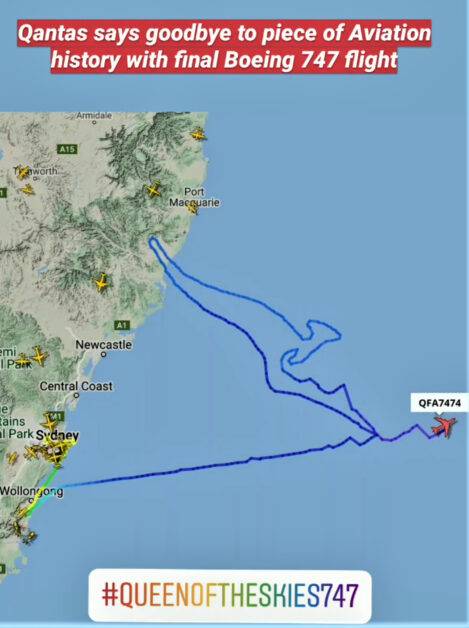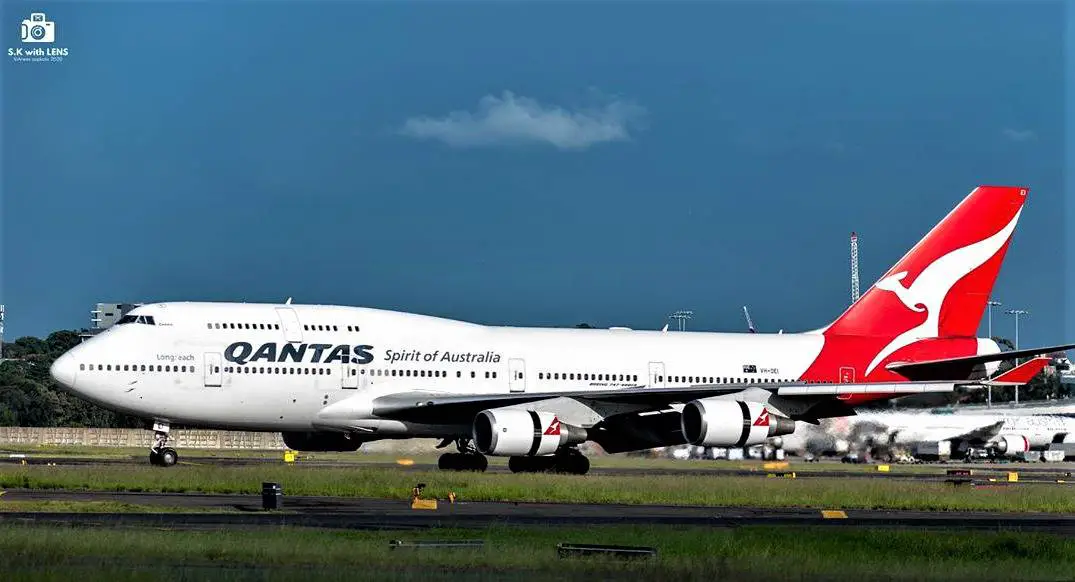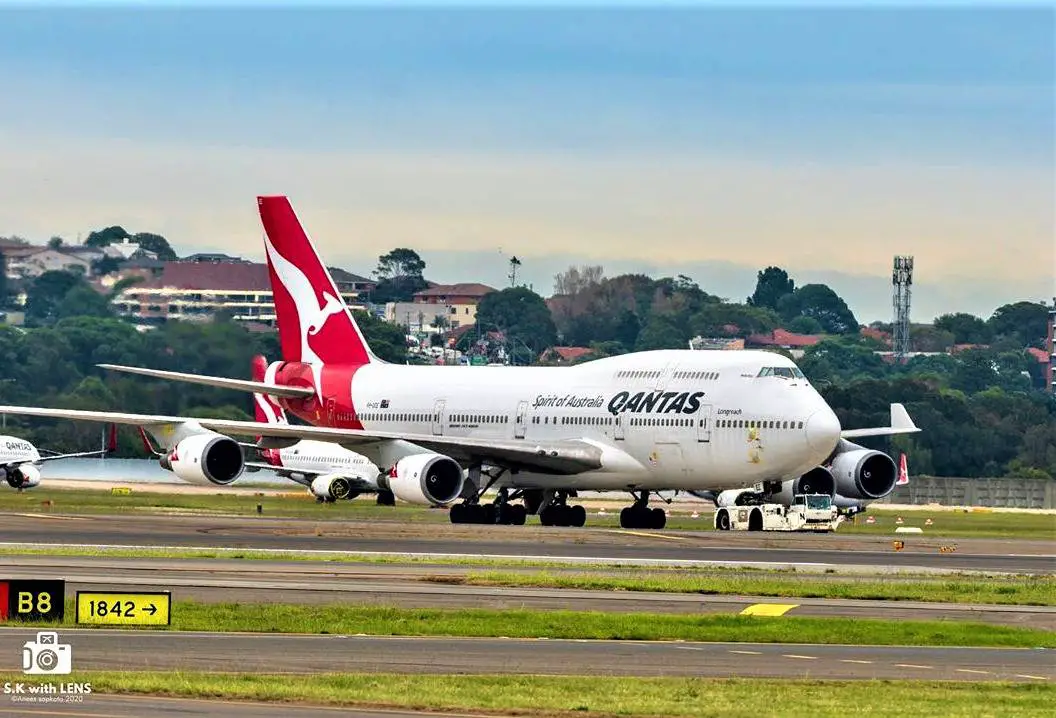The Australian flag carrier waved goodbye to the Boeing 747 era that lasted for 50 years accumulating lots of flight hours and memories.
Qantas organized a farewell flight today with its final Boeing 747-400 plane which took off from Sydney Airport and paid tribute to the Qantas branding logo (kangaroo icon) by tracing flight path in the skies.

Qantas introduced iconic Boeing 747 in August 1971 and the 747s have made lots of international flights serving millions of Australian and international passengers.
Not only in commercial flights, but Qantas 747s were also used to rescue people during Cyclone Tracy in 1974 and evacuate Australians from the dangers of political unrest in Cairo, Egypt. It also airlifted medical supplies during the Boxing Day Tsunami.

The latest and last mission of Qantas 747 was the rescue and repatriation flights for Australian citizens from Coronavirus epicenter in Wuhan, China.
Qantas CEO Alan Joyce said in a statement, “Time has overtaken the 747 and we now have a much more fuel efficient aircraft with the even better range in our fleet, such as the 787 Dreamliner that we use on Perth-London and hopefully before too long, the Airbus A350 for our Project Sunrise flights non-stop to New York and London.”
The United Kingdom national carrier British Airways has also decided to retire all its Boeing 747 aircraft.
ABOUT BOEING 747

The Boeing 747 was the result of the work of some 50,000 Boeing people. Called “the Incredibles,” these were the construction workers, mechanics, engineers, secretaries, and administrators who made aviation history by building the Boeing 747 — the largest civilian airplane in the world — in roughly 16 months during the late 1960s.
The incentive for creating the giant Boeing 747 came from reductions in airfares, a surge in air passenger traffic, and increasingly crowded skies. Following the loss of the competition for a gigantic military transport, the C-5A, Boeing set out to develop a large advanced commercial airplane to take advantage of the high-bypass engine technology developed for the C-5A. The design philosophy behind the Boeing 747 was to develop a completely new plane, and other than the engines, the designers purposefully avoided using any hardware developed for the C-5.
The 747’s final design was offered in three configurations: all passengers, all cargo, and a convertible passenger/freighter model. The freighter and convertible models loaded 8- by 8-foot (2.4- by 2.4-meter) cargo containers through the huge hinged nose.
The Boeing 747 was truly monumental in size. The massive airplane required the construction of the 200 million-cubic-foot (5.6 million-cubic-meter) 747 assembly plant in Everett, Wash., the world’s largest building (by volume). The fuselage of the original 747 was 225 feet (68.5 meters) long; the tail as tall as a six-story building. Pressurized, it carried a ton of air. The cargo hold had room for 3,400 pieces of baggage and could be unloaded in seven minutes. The total wing area was larger than a basketball court. Yet, the entire global navigation system weighed less than a modern laptop computer.
Pilots prepared for the Boeing 747 at Boeing training school. The experience of taxiing such a large plane was acquired in a contraption called “Waddell’s Wagon,” named after Jack Waddell, the company’s chief test pilot. The pilot sat in a mockup of the 747 flight deck built atop three-story-high stilts on a moving truck. The pilot learned how to maneuver from such a height by directing the truck driver below him by radio.
The National Aeronautics and Space Administration later modified two 747-100s into Shuttle Carrier Aircraft. The next version, the 747-200, holds approximately 440 passengers and has a range of about 5,600 nautical miles (10,371 kilometers). In 1990, two 747-200Bs were modified to serve as Air Force One and replaced the VC-137s (707s) that served as the presidential airplane for nearly 30 years. The 747-300 has an extended upper deck and carries even more passengers than the -200.
The 747-400 rolled out in 1988. Its wingspan is 212 feet (64 meters), and it has 6-foot-high (1.8-meter-high) “winglets” on the wingtips. The 747-400 also is produced as a freighter, as a combination freighter and passenger model, and as a special domestic version, without the winglets, for shorter range flights.
In August 1999, major assembly began on a militarized 747-400 Freighter to be used as a platform for the U.S. Air Force’s Airborne Laser (ABL) program. It rolled out on Oct. 27, 2006, and was eventually designated YAL-1. Boeing was the prime contractor for ABL, which was designed to provide a speed-of-light capability to destroy all classes of ballistic missiles in their boost phase of flight. Boeing provided the modified aircraft and the battle management system and is the overall systems integrator. ABL partners were Northrop Grumman, which supplied the chemical oxygen-iodine, or COIL, high-energy laser associated lasers, and Lockheed Martin, which provided the nose-mounted turret in addition to the beam control/fire control system. On Feb. 11, 2010, the flying testbed destroyed a ballistic missile off the coast of Southern California. The program was canceled in 2011, and in 2012, YAL-1 was flown to the U.S. Air Force “boneyard” near Pima, Ariz., to be scrapped.
Another variant is the Dreamlifter — a specially modified 747-400 — that transports the large composite structures, including huge fuselage sections of the 787 Dreamliner, from partners around the world to Everett, Wash., and Charleston, S.C., for final assembly. The massive cargo is loaded and unloaded from a hinged rear fuselage. The fourth and final Dreamlifter entered service Feb. 16, 2010.
The longer-range 747-400 airplanes (also known as 747-400ERs) was launched in late 2000. The 747-400ER (Extended Range) family is available in both passenger and freighter versions. The airplanes are the same size as current 747-400s and have a range of 7,670 nautical miles (14,205 kilometers) as opposed to the 747-400 range of 7,260 nautical miles (13,450 kilometers). It incorporates the strengthened -400 Freighter wing, strengthened body and landing gear, and an auxiliary fuel tank in the forward cargo hold, with an option for a second tank. When the 747-400ER’s full-range capability is not needed, operators can remove the tank (or tanks), freeing up additional space for cargo.
In November 2005, Boeing launched the 747-8 family — the 747-8 Intercontinental passenger airplane and the 747-8 Freighter. These airplanes incorporate innovative technologies from the 787 Dreamliner. In fact, the designation 747-8 was chosen to show the technology connection between the 787 Dreamliner and the new 747-8, including the General Electric GEnx-2B engines, raked wingtips and other improvements that allow for a 30 percent smaller noise footprint, 15 percent reduction in-service carbon emissions, better performance retention, lower weight, less fuel consumption, fewer parts, and less maintenance.
The 747-8 Freighter first flew on Feb. 8, 2010. The airplane is 250 feet, 2 inches (76.3 meters) long, which is 18 feet, 4 inches (5.6 meters) longer than the 747-400 Freighter. The stretch provides customers with 16 percent more revenue cargo volume compared with its predecessor. That translates to an additional four main-deck pallets and three lower hold pallets.
The passenger version, the Boeing 747-8 Intercontinental, serves the 400- to 500-seat market and took its first flight on March 20, 2011. The cabin’s sculpted ceilings, bigger overhead, and side stow bins, a redesigned staircase, and dynamic LED lighting all to add to an overall more comfortable passenger experience. With 51 additional seats and 26 percent more revenue cargo volume than the 747-400, Boeing delivered the first 747-8 Intercontinental to an undisclosed Boeing Business Jet customer on Feb. 28, 2012. Launch customer Lufthansa took delivery of the first airline Intercontinental April 25, 2012.
On June 28, 2014, the company delivered the 1,500th Boeing 747 to come off the production line to Frankfurt, Germany-based Lufthansa. The 747 is the first wide-body airplane in history to reach the 1,500 milestones.





